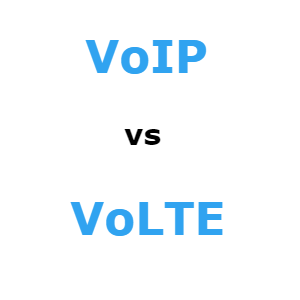Are you wondering what the differences between VoIP and VoLTE are? If so, you’re in the right place as we’re about to take you through the rundown of what these services are and how their features differ from one another.
VoIP is Voice Over Internet Protocol and VoLTE is ‘Voice Over LTE’ or ‘Voice Over Long Term Evolution’. Both of them are similar in that they use the internet to have data and voice information sent. You’re able to use both services to make calls by using the internet.
However, there are some differences in the way that these communications are used through the internet.
Our Comparison of VOLTE vs VoIP
What is VoLTE?
VoLTE implements 4G technology to send packets of digital data. VoIP operates on 3G networks, which makes the voice and data capacity smoother to manage compared to VoIP.
What is VoIP?
VoIP allows you to turn an audio signal into packets that are digital so that they can be sent across the internet using a 3g network. Essentially, it works like sending an email, except the data that gets sent includes voice and not written words.
VoLTE & Long Term Evolution
The long term evolution part is one of the big factors that makes VoLTE so different to VoIP. Long term evolution refers to service being able to send more data over the internet, with increased speed and smoothness.
3G & 4G
While 3G networks are a substantial step up from the 2G networks, the 4G networks used by VoLTE services are another step up from 3G networks.
The 4G networks that VoLTE uses allow for more data to be transferred faster than 3G networks that are used with VoIP services.
VoLTE & QoS Components
When VoIP services send voice and data, it gets transferred like any regular type of data on the internet. VoLTE has a QoS (Quality of Service) component which allows for a stronger internet connection and less errors with data being sent. Therefore, it can be a smoother way of making calls using the internet.
To ensure that the quality of the calls are up to a high standard, there’s a dedicated radio frequency available too.
SR-VCC
The SR-VCC component is a critical part of VoLTE systems. If you use your phone outside of the area that VoLTE can cover, the SR-VCC comes into play and is automatically activated.
Upon this activation, it connects you back to the VoLTE system as well as a legacy network which is older but ensures that you have a connection again. The radio frequency helps during this process by implementing the IMS system to let you continue using the VoLTE services.
What is IMS?
IMS stands for IP Multimedia Subsystem. The IP (internet protocol) operates with a wireless or landline system. When it’s being used with VoLTE, it helps with strengthening how the digital data and voice packers are transmitted.
Voice Quality
One of the features that VoLTE users can really take advantage of is how their voices are transmitted in high definition. This is because VoLTE systems enable voice data to be encoded with a wideband audio that lets your voice be heard in high quality.
The IMS system also helps your voice to be heard in high definition by keeping the transmissions of digital voice packets strong.
VoLTE voice calls are usually higher quality than VoIP phone calls. Having said that, the high definition voice features can only be appreciated if the people on the other end have phones that are capable of listening to voices in HD. if not, the high definition voice quality won’t make a difference to whoever you’re speaking to.
Speed & Energy Efficiency
VoLTE systems allow you to have your calls connected on their 4G network faster than VoIP services can on 3G networks.
Even if you’re on a congested network, VoLTE services are still able to provide you with a high quality voice call experience.
Furthermore, the digital data packets that are sent with VoLTE are more compact which means that less energy is used up. So, you can be sure to get more battery life out of devices with VoLTE systems.
Conclusion
That wraps up our post about some of the key differences between VoIP and VoLTE services.
The main differences are in the type of technology that these services use. VoLTE uses 4G networks and IMS frameworks to allow for more data to be transferred in more compact packets. It also means stronger and smoother connections.
VoIP is easy to access and their services are considered to be reliable. However, the speed of VoLTE services is what attracts many businesses to use those services instead.
You can use the information found in this post to help you decide on whether to use VoIP or VoLTE systems. They both allow you to make calls by using the internet, but many businesses find the VoLTE to be superior.

